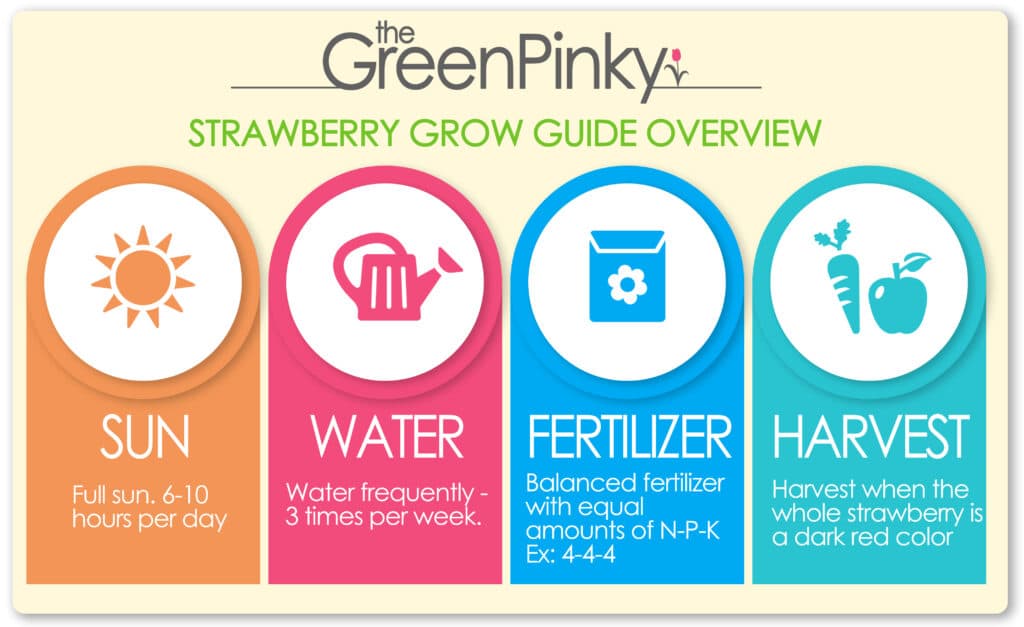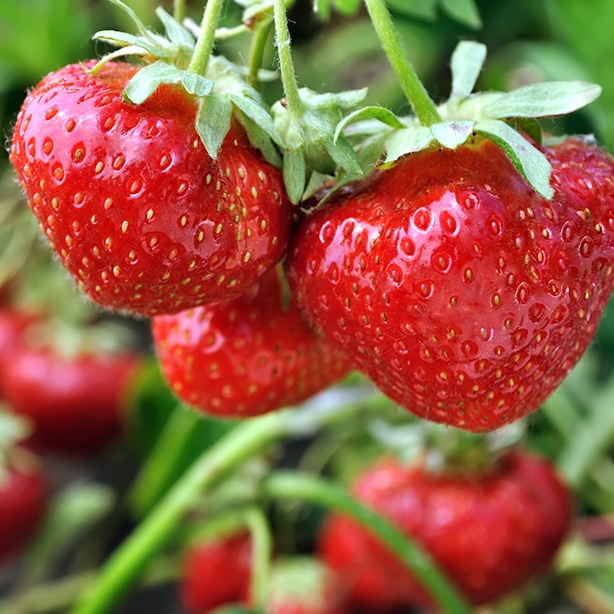Growing strawberries is fun and rewarding….and the harvests are absolutely delicious.
Learn everything you need to know about growing and caring for a strawberry plant. The tips below will set you up for success!

Different Types
There are two broad categories of strawberries: June bearing and everbearing.
June bearing varieties fruit heavily in June. Common varieties within this category include Cavendish, Sparkle, and Allstar. These types do not bear fruit the first year they are planted. Instead, they bear fruit in their second summer.
Everbearing types produce fruit starting making fruit after their first growing season. They produce fruit in smaller batches, but they do so from early to late summer. They are also often known as day neutral varieties. Even though the terms do not exactly mean the same thing, they are used interchangeably these days. Common varieties within this category include Albion, Monterey, and Seascape.

Buying Strawberry Plants
When you buy strawberry plants, be sure to select a variety that does best in your climate zone.
It is easiest to plant rootstock (bare roots), rather than seeds. Vendors usually sell them in packs of 25 plants. Try your best to have your new plants arrive after your last frost date. Strawberries are quite hardy, but young plants will be more tender to cold weather. Depending on the space you have available for your plants, you can choose to select any combination of June bearing or everbearing varieties.

Preparing Your Home Garden
While designing your garden, it is essential to take a couple things into account:
- Plants should be spaced about 12 inches apart.
- The most common way to plant them is to create a bed that is 18 inches wide. Within this bed, plant two rows of plants 12 inches apart.
- Creating a raised bed can make it a little easier for you to harvest your fruit when they’re ready. The easiest way to make a raised bed is to rake soil from your pathways onto your planting area so that the planting area becomes elevated off the ground. This also helps keep your plants from getting flooded during a rainstorm.
- If you will create multiple beds, make sure your garden paths have enough room. You will want to have room to sit down comfortably. You will also need space to accommodate your harvesting container.
If you are growing in a cooler climate (zone 7 or cooler), you may want to consider having two patches, so you can rotate plantings and have a steady plants growing every year.
When you plan out your patch, make sure to find a place that is not shaded. Strawberries require full sun. The full sun requirement means that your plants should be receiving anywhere from 6 to 8 hours of sun per day.
It is also an excellent idea to gather mulch to place around the base of your plants to keep them and the surrounding areas weed-free. Straw, woodchips, acorns, cocoa chips are all great options. You can also use landscape fabric to keep the area weed-free; simply create holes in the fabric for the plants themselves.
Strawberries also need frequent watering. So, when you are setting up your garden, you may also want to set up an irrigation system, such as a soaker hose setup.

Steps by Step Guide
Unpacking Your Plants
Try to time the arrival of your rootstock with the last frost. This way you can plant them immediately as your ground has already thawed and the danger of freezing has passed.
When you open your package, you will notice that the plants have a few leaves but long, fibrous bare roots. Keep the sets in their labeled rubber bands and place the bare root in a vessel with a few inches of water, to hydrate them. You can also mix a gentle fertilizer in the water to help the plants grow after rooting.
Soil Preparation
If your soil is dry, you should hydrate it before creating holes and planting. Create garden stakes to make labels for each variety you will be growing and have them ready once you plant.
Use a ruler or stake marked at 12 inch increments to keep yourself organized while planting. Use a hand trough to create a hole 6 inches deep to place them in.
Transplanting Your Plants
Take a banded group of one variety from your bucket or bowl. Make sure your garden stake matches the label. Plant one strawberry plant in each hole.
Use your palms to pull the soil in toward the root ball. Your goal is to have the surface of the soil level with the midpoint of the crown. The crown is the central area where the leaves and roots meet. You should have the soil surface right in the middle of the crown. If you are planting a bed with two rows, make sure you are planting both rows together, so you have one patch of each type.

Ongoing Maintenance
Add Mulch
Now that your strawberries are in their new home and ready to grow, it’s time to apply your mulch of choice.
Be gentle around your new plants; they will thank you later. Mulch helps prevent weeds, hold moisture, feed the soil microbes, and give the fruit a clean, dry place to rest while growing. This also helps keep them disease free as they grow.
You can use the same mulch in your paths and around your plants. If you live in a climate that gets below freezing temperatures for more than a few days, you should use straw to cover your plants in the winter. You can rake this off into the aisles next spring.
Food and Water
Water at least three times per week and fertilize once per week to help your plants receive the appropriate nutrients. A fertilizer equally balanced in N-P-K is sufficient (such as 4-4-4 or 10-10-10). Alfalfa, fish fertilizer, and mature compost are all excellent amendments you can include.

Pruning
Strawberry plants have roots, leaves, flowering stems, and runners (called stolons). June-bearing types should have all their flowers and runners pinched off their first year. By doing this, you will help your plants bear more fruit in its second season.
In contrast, everbearing types should have all their runners pinched off, every year. They should have all their flowers pinched off until at least mid-July to encourage big, beautiful plants. After mid-July, you should let them set fruit.
Harvesting
Most strawberries will turn completely dark red when they are ready to be harvested. Only a couple varieties will still have small areas of white because the leaves cover the fruit and do not allow the whole fruit to ripen.

Short-lived Perennials
Strawberry plants are short-lived perennial plants, which means they will live for more than one year.
If you live in cooler growing zones (hardiness zones 4-6), they will grow well for a couple of years, and then should be swapped out with fresh plants. If you live in zone 7 or warmer, you may be able to keep the same plants for five or more years.
Enjoying Your Effort
Growing strawberries requires a little bit of planning, but taking the time to care for this plant will reward you with some of the most delicious fruit you’ve eaten! They are healthy, cold-hardy plants that will reward you and your family for years to come!
Now that you have the basics figured out, have fun creating your strawberry garden!

